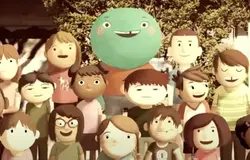
EDUCATIONAL FILM LITERACY
School bullying - Diversity
WELCOME TO MY LIFE by Elizabeth Ito

WELCOME TO MY LIFE
by Elizabeth Ito
Recommended ages: 10-12+
Watch this exclusive short about a day in the life of Douglas aka T-Kash, a monster trying to fit in at his high school.
Subjects:
Difference - Inclusion - Bullying - Bias -
Self-Identity - Acceptance
First Look
INTRODUCE THE FILM
-
We’re going to watch WELCOME TO MY LIFE, by Elizabeth Ito.
-
The film is about 8 minutes long.
-
It’s important not to talk or take notes during the first viewing, since it may cause you to miss something important! In a short film, every image and sound is important to the story being told.
-
We will watch the film again later in the lesson.
Watch the film:
Watch the film together and gather initial reactions using open-ended questions.

WELCOME TO MY LIFE by Elizabeth Ito I PsarolocoEdu

START THE CONVERSATION
Follow the film screening with a moment of pause for the group to gather their thoughts. Ask the open-ended questions below and record students’ answers. Have students support their observations with evidence by asking, “What did you see that makes you say that?”
-
What did you notice? What did you see?
-
How would you describe the style of this film?
-
What words come to mind when you hear the word documentary?
-
In what ways was this film similar and/or different from a documentary?
-
This film is considered a mockumentary. What do you think the word mockumentary might mean?
-
Visit the Glossary for definitions of these terms and be sure to note that a mockumentary is meant to be humorous and is different from a fake-documentary that might intend to mislead or misinform people.
 |  |  |  |
|---|---|---|---|
 |  |  |
A Closer Look
MOVE THE CONVERSATION FURTHER
Consider posing a question before screening the film again and have students take notes while viewing the film this time.
PROTAGONIST & ANTAGONIST
From what we can see in the film, what do we know about the protagonist, T-Kesh? How do we know this?
What don’t we know about T-Kesh? What do we wonder about this character?
What do we know about the antagonist, Ian? How do we know that?
What don’t we know about Ian? What do we wonder about Ian?
Why do you think Ian might have treated T-Kesh the way he did? What assumptions might Ian have made about T-Kesh?
IDENTITY
When we meet someone new, our name is usually the first thing we share. Have students consider:
What might T-Kesh’s name reveal about his identity? Remember that his full name is Takeshi and that T-Kesh is his nickname.
What words or phrases does T-Kesh use to describe his own identity?
What are some of the interests that T-Kesh talks about in the film? Can we learn anything about T-Kesh based on his interests?
What might your own name or nickname tell others about your identity? What stories about you or your family might your name reflect? What about your identity is simplified, hidden, or confused by your name?
Modifications
Ask students to make a list of words, phrases, and/or character traits that come to mind when describing the characters in the film. Students can work on the list while rewatching the film or you can use still images by pausing the film.
The Big Conversation
EXPAND CONVERSATIONS AND CONNECT TO SUBTHEMES
MONSTERS & STEREOTYPES
-
Create a T-chart. On one side of the chart, have students list words that they might use to describe a monster. Since monsters are fictional, there are no wrong answers.
-
On the other side of the chart, list words you might use to describe T-Kesh.
-
Compare the two lists to see how T-Kesh is similar or different from what you might expect from a monster.
-
What assumptions might Ian have made about T-Kesh or about monsters in general that might have caused him to treat T-Kesh the way he did?
-
Ask students to help define the word stereotype. Explain that when we make assumptions about an entire group of people, those assumptions are referred to as stereotypes. When stereotypes influence our behavior or attitudes, we may find it difficult to make fair judgements about someone or something. This influence on judgement is called a bias.
FAMILY AND IDENTITY
Our families can be an important part of our identities. In small groups or pairs have students revisit and reflect on the following:
-
T-Kesh says: “It seems like Japanese monsters are pretty common in cinema, but I don’t know if regular people would know that that’s, like, a normal thing…” What do you think T-Kesh means by this?
-
T-Kesh uses the phrases regular people and normal thing. What can you say about words like ‘normal’ or ‘regular’ and how they are used and interpreted by different people?
-
Do you think these are useful terms?
-
T-Kesh’s mom says “…in today’s world there are all kinds of people and people are becoming more tolerant of…different kinds of parenting styles and different family configurations…accepting a monster just kind of goes along with that.” What do you think T-Kesh’s mother means by this? Does this remind you of anything that you’ve heard or experienced in real life?
Emphasize that answers to these questions, like the other conversations you are having, are non-judgemental and provide students with an opportunity to consider their own experiences—and the importance of reflecting on their own actions and thoughts.
Source: FilmEd Classroom, New York International Children’s Film Festival’s

